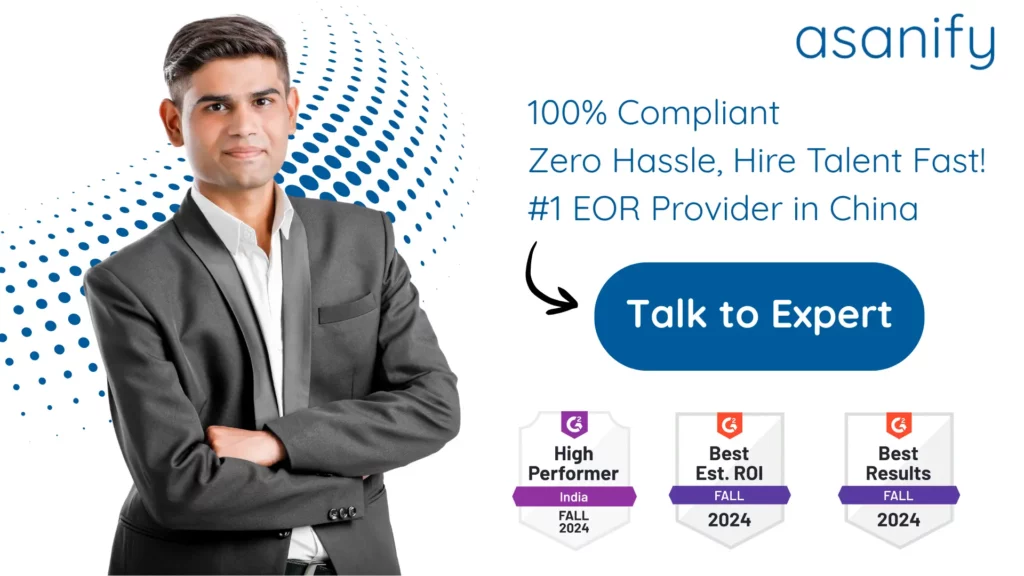China continues to dominate the global outsourcing landscape in 2025 — not just as a manufacturing giant, but as a thriving hub for IT, engineering, design, and business process services. Its combination of cost efficiency, technical expertise, and scalable talent makes it a go-to destination for companies worldwide, especially for mid to large-scale projects that require long-term execution and rapid growth.
Whether you’re a U.S. tech firm building a backend team or a European retailer outsourcing customer support, China’s maturing digital economy and outsourcing infrastructure make it an attractive choice. This guide covers everything you need to know: from benefits and legal frameworks to service types, challenges, and how to use Employer of Record (EOR) services to outsource work to China compliantly.
Table of Contents
- What is Outsourcing and Why Do Companies Do It?
- Overview of the Outsourcing Industry in China
- Why is China a Hotspot for Outsourcing in 2025?
- What Types of Work Can You Outsource to China?
- Three Commonly Outsourced Services in China
- Step-by-Step Guide to Outsourcing to China
- Best Practices for Outsourcing to China
- Pros and Cons of Outsourcing to China
- Legal and Compliance Framework in China
- Cost Breakdown – How Much Can You Save?
- Outsourcing Projects from the USA to China
- Conclusion
- FAQs
What is Outsourcing and Why Do Companies Do It?
Outsourcing is a strategy where organizations delegate non-core or specialized tasks to external vendors or professionals. This enables businesses to streamline costs, scale quickly, focus on innovation, and access skill sets unavailable in-house.
Companies outsource work to China not just to save money, but to tap into a massive talent pool of engineers, designers, analysts, and support agents. Modern outsourcing is no longer limited to call centers — it now includes AI development, compliance consulting, software architecture, and global customer support.
China supports all of these services with a maturing legal system, strong technical education pipeline, and a digital-first approach to business collaboration.
Overview of the Outsourcing Industry in China
China’s outsourcing industry is among the most mature globally, with thousands of service providers offering IT, BPO, KPO, and specialized engineering support. The country has invested heavily in R&D zones, digital infrastructure, and English-language upskilling to cater to global clients.
Major outsourcing hubs include Beijing, Shanghai, Shenzhen, Chengdu, and Hangzhou — cities that boast strong internet infrastructure, world-class universities, and advanced IT ecosystems. The Chinese government actively supports the outsourcing sector through tax breaks, special economic zones (SEZs), and talent programs.
With over 5 million STEM graduates annually and growing proficiency in AI, cloud, and cybersecurity, China has evolved from a cost-saving hub to a center for digital transformation partnerships.
Why is China a Hotspot for Outsourcing in 2025?
1. Large, Technically Proficient Talent Pool
China produces more engineers and developers than any other country. Its workforce is proficient in Python, Java, DevOps, AI/ML, blockchain, and data analytics. Vendors specialize in both mass-scale and high-complexity software projects.
2. Cost-Efficiency with High Output
Labor and infrastructure costs are lower than in Western Europe or North America. Chinese outsourcing firms deliver fast turnaround times, often at half the cost of Western providers.
3. Evolving Data Security and IP Protection
The updated Data Security Law (DSL) and Personal Information Protection Law (PIPL) bring China’s regulations closer to GDPR standards. Many vendors hold ISO 27001 certifications and offer GDPR-compliant frameworks for cross-border clients.
4. Infrastructure and Innovation
China leads in cloud computing, 5G, and fintech innovation. With tools like Alibaba Cloud, Huawei Cloud, and Tencent’s enterprise platforms, Chinese vendors offer cutting-edge digital ecosystems.

What Types of Work Can You Outsource to China?
China supports both technical and non-technical outsourcing functions across nearly all industries. Commonly outsourced roles include:
- Full-stack software and app development
- AI/ML model training and data annotation
- CAD and industrial design services
- Multilingual customer support (Mandarin, English)
- Product sourcing and quality assurance
- Compliance documentation for international trade
- UI/UX design for global SaaS products
- Digital marketing and SEO for APAC
- Accounting and financial reporting
Chinese vendors are particularly suitable for high-volume, precision-based work where scalability, speed, and price efficiency matter.
Suggested Read: Employer of Record China: A Comprehensive Guide
Three Commonly Outsourced Services in China
1. Software Development and AI Engineering
China’s software developers are well-versed in scalable backend systems, frontend frameworks like React or Vue, and advanced AI/ML capabilities. Shenzhen and Hangzhou are home to some of the world’s fastest-growing tech firms.
2. Product Design and Industrial Engineering
Companies outsource CAD modeling, 3D prototyping, and embedded system design to Chinese engineers. China’s legacy in electronics and manufacturing translates well into high-end product development outsourcing.
3. Multilingual Support and eCommerce Operations
China is a hub for eCommerce platforms. Businesses often outsource Mandarin-English customer service, localization, and inventory support to Chinese firms that understand global buyer behavior and APAC logistics.
Step-by-Step Guide to Outsourcing to China
- Define Scope
Choose whether you need software, support, design, or manufacturing coordination. Document functional specs, compliance needs, and language requirements. - Vendor Discovery
Use platforms like Clutch, GoodFirms, or Chinese tech parks’ directories to shortlist partners. Match based on scale, technical niche, and experience with global clients. - Due Diligence
Verify business licenses, ISO certifications, security frameworks, and existing clientele. Ask about compliance with PIPL and cross-border data handling. - RFP Process
Share detailed RFQs or RFPs. Evaluate responses for pricing, response quality, timezone overlap, and process maturity. - Virtual Tour or Demo
Use Zoom, DingTalk, or WeChat to evaluate communication fluency, technical presentation, and operational transparency. - Contract Negotiation
Include clauses covering IP, deliverables, jurisdiction (often Hong Kong arbitration), non-competes, SLAs, and data usage. - Onboarding
Provide SOPs, credentials, DevOps access (if applicable), toolkits, and brand guidelines. - Integration
Use collaborative tools like Zoom, Jira, GitLab, or Feishu (Lark) to bridge workflows. - Performance Review
Run weekly syncs and quarterly business reviews (QBRs). Address cultural gaps and feedback loops regularly.
Best Practices for Outsourcing to China
- Clarify Deliverables in Writing: Avoid ambiguity — use diagrams, videos, and multi-language docs if necessary.
- Appoint a Local Liaison or Translator: For smoother onboarding and ongoing communication.
- Use an EOR for Hiring-Based Engagements: An Employer of Record ensures tax, social insurance, and contracts are compliant.
- Provide Brand & System Training: Especially for customer-facing roles and localized design.
- Schedule in Advance: Account for timezone differences (China Standard Time is UTC+8).

Pros and Cons of Outsourcing to China
| Pros | Cons |
| Large, skilled, and cost-effective workforce | Timezone challenges for U.S. and EU-based teams |
| Strong technical expertise in AI, hardware, and software | Language barriers may affect some engagements |
| Advanced digital infrastructure and cloud access | PIPL and data laws can complicate cross-border workflows |
| Mature outsourcing hubs with English support teams | Occasional concerns around IP unless protected contractually |
Legal and Compliance Framework in China
China has a strict labor laws environment governing data privacy, labor contracts, and cross-border transactions. All outsourcing agreements must comply with the Cybersecurity Law, Personal Information Protection Law (PIPL), and Data Security Law, especially when handling sensitive or personal data. Contracts should clearly define IP ownership, jurisdiction, and dispute resolution mechanisms. Partnering with a local legal advisor is recommended to ensure compliance with both national and regional regulations.
China’s outsourcing environment is governed by:
- PIPL (Personal Information Protection Law) – Protects personal data, similar to GDPR.
- DSL (Data Security Law) – Governs how data is processed, stored, and exported.
- Cybersecurity Law – Ensures vendor compliance with security protocols.
To ensure compliance:
- Choose vendors with ISO 27001 and/or GDPR-adapted processes.
- Work with EOR providers to legally hire or manage remote employees in China without creating a legal entity.
- Sign NDAs, Non-Competes, and clearly defined IP ownership clauses.
Cost Breakdown – How Much Can You Save?
| Role | Monthly Cost (China) | Monthly Cost (Western EU/UK) |
| Developer | ¥12,000–¥18,000 (approx. €1,500–€2,200) | €8,500–€11,000 |
| Legal/Compliance Consultant | ¥15,000–¥25,000 | €7,500–€10,000 |
| Support Agent | ¥8,000–¥12,000 | €4,800–€6,500 |
China offers a 40–60% cost advantage on average, especially when EORs are used to streamline onboarding and processing payroll.

Outsourcing Projects from the USA to China
U.S. companies continue to rely on Chinese partners for design, development, manufacturing coordination, and more. Despite regulatory complexities, the cost savings and deep technical pool make China an essential outsourcing destination.
Use Cases:
- U.S. SaaS companies building MVPs and AI modules with Chinese dev teams
- Consumer brands outsourcing UI design and packaging design to Shenzhen studios
- Logistics firms automating supply chain systems through Beijing-based vendors
- eCommerce businesses outsourcing Mandarin customer support for Chinese markets
Suggested Read: Understanding Labour Laws in China: Contracts, Wages, and Termination Rules
Conclusion
Outsourcing to China in 2025 is no longer just a manufacturing decision—it’s a strategic move for companies aiming to access deep technical talent, cost advantages, and specialized services in engineering, AI, and back-office functions. With its expansive workforce, robust digital infrastructure, and growing regulatory clarity, China enables scalable outsourcing partnerships that serve both startups and global enterprises across multiple sectors.
Take the next step and explore partnerships with trusted Chinese service providers—or simplify your global expansion with a platform like Asanify, which connects you with compliant, pre-vetted vendors to ensure smooth onboarding, secure operations, and adherence to Chinese labor laws.
FAQs
Yes. It offers skilled engineers, strong cloud infrastructure, and affordable development.
Yes, through outsourcing firms or EOR providers.
Mandarin is primary, but most leading vendors offer fluent English support.
Yes, if vendors are PIPL-compliant and you use strong contractual protections.
No, you can work with vendors directly or hire through an EOR.
Zoom, Jira, Feishu (Lark), WeChat Work, DingTalk, GitHub.
Shenzhen, Beijing, Shanghai, Chengdu, Hangzhou.
Not to be considered as tax, legal, financial or HR advice. Regulations change over time so please consult a lawyer, accountant or Labour Law expert for specific guidance.

